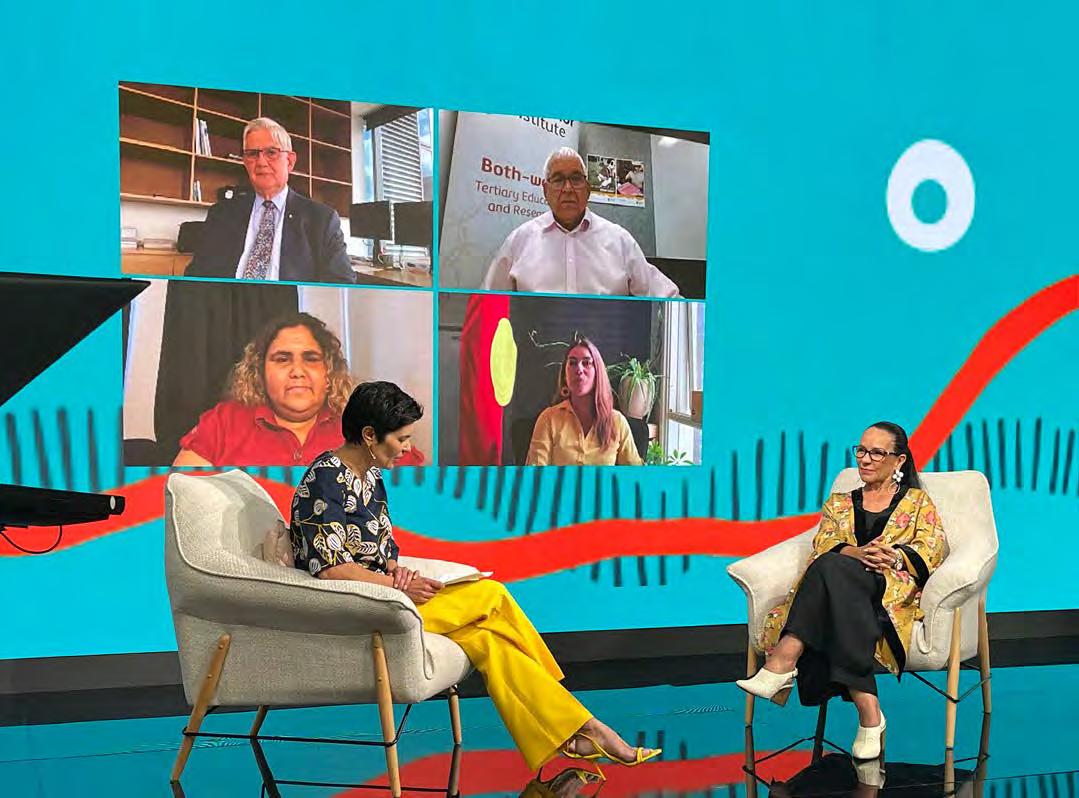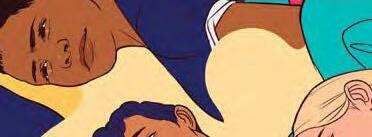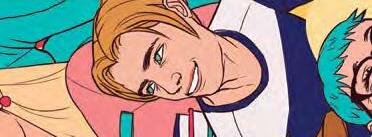
7 minute read
The Australian Reconciliation Convention


The 2021 Australian Reconciliation Convention was the third national reconciliation gathering. The first was in Melbourne in 1997, and it had been 21 years since Corroboree 2000.
Each of these events marked a different stage in Australia’s reconciliation journey.
At Corroboree 2000, the Council for Aboriginal Reconciliation handed two documents to key politicians and the Australian public; the Australian Declaration Towards Reconciliation and the Roadmap for Reconciliation.
Above: Panellists during the final Australian Reconciliation Convention plenary session ‘Where do we want to be in 20 years?’. In studio l-r: Narelda Jacobs, The Hon Linda Burney MP. On screen clockwise from top left: The Hon Ken Wyatt AM MP, Mick Gooda, Senator Lidia Thorpe, and Sally Scales. Photo: Peter Morris Out of those documents came the guiding message; Our hope is for a united Australia that respects this land of ours; values the Aboriginal and Torres Strait Islander heritage; and provides justice and equity for all.
The next day more than 250,000 people marched across the Sydney Harbour Bridge in support of reconciliation and justice.
Fast forward to 2021: Reconciliation Australia’s 20th anniversary as the organisation that was tasked to take reconciliation forward after Corroboree 2000.
The 2021 Australian Reconciliation Convention would consider how far the reconciliation movement had come and how to continue to build a just, equitable and reconciled future. Three days; 30 sessions; and a 100 speakers and contributors; joined by around 1500 attendees. All together at this one point in time.
Except, of course, we were together virtually as the event was broadcast live online from the beautiful lands of the Cammeraygal people of the Eora Nation, due to COVID-19.
The Convention built on the National Reconciliation Week (NRW) 2021 theme, More than a word. Reconciliation takes action, which asked people to move from safe to brave action for reconciliation.
Present on everyone’s minds was the enduring work of all those who had come before – the work of millions of Australians throughout the 30 years of the formal Australian reconciliation process.
POSTER OVERLEAF















National Reconciliation Week is a time for all Australians to learn about our shared histories, cultures, and achievements, and to explore and reflect on how each of us can contribute to reconciliation in Australia.
Head to nrw.reconciliation.org.au to get involved.
We need to demand more. We need to step up as leaders. All of us, we have this in ourselves. - Sally Scales
Day one – looking back to look forward
The first day of the Convention set the scene with the plenary Honouring the Past, presenting a powerhouse discussion between Dr Jackie Huggins, Uncle Bill Lowah, Fred Chaney and Shelley Reys, guided by Kerry O’Brien.
They covered off on the national markers in the reconciliation journey – the 1967 Referendum, the NT Land Rights Act, the Mabo decision, the Royal Commission into Aboriginal Deaths in Custody, the establishment of the Council for Aboriginal Reconciliation, the National Inquiry Into The Separation of Aboriginal and Torres Strait Islander Children From Their Families – and how those and other events set the course we are on today.

“The stolen generations inquiry and report was a landmark for our people to speak their truth and tell their stories. Right now the truth-telling process is timely.’ – Dr Jackie Huggins
“Mabo, as a matter of law and the extreme reaction to it was because people realised this was the biggest shift in the balance of power between Aboriginal and non-Aboriginal people since 1788.” – Fred Chaney.
With a new generation now taking up the challenge, influenced and educated by the historic actions of the trailblazers before them, what was the final advice from this panel?
“Hope, Buoyancy and Optimism, that’ll do me. Get on the wild ride. Blackfellas are offering a wild ride. Get on it. Find out what it’s all about!” – Uncle Bill Lowah.
The day held and delivered many important discussions about racism, especially the scourge of systemic racism.
Examples included the intentional removal of First Nations histories from our curriculum, the over-representation of Aboriginal and Torres Strait Islander people in our prisons and detention centres, and the denial of jobs and opportunities. “If there’s a lot of good will and nothing changes, it is a symptom of a structural issue.” – Professor Larissa Behrendt.
Day two – reconciliation through truth-telling
The second day of the Convention focussed firmly on truth-telling and on ensuring all our efforts towards a just and reconciled Australia are on solid foundations.
Truth-telling is powerful not only because we acknowledge the real truths of our history, but also because it shows the strength and resilience of Aboriginal and Torres Strait Islander peoples and cultures. Community truth-telling, survivor-led healing, and institutional truth-telling panels all explored the importance of truth-telling to moving forward, as well as what happens when the truth comes out. Once again, we were honoured by the strength of speakers who contributed to these discussions including Aunty Eleanor Bourke, Aunty Lorraine Peeters, Uncle Michael Welsh, Rachel Perkins, Chelsea Watego and Carmen Parahi. The Convention was a timely reminder of the breadth of all the work being done by the reconciliation movement and the work still to be done.
We have recently witnessed reconciliation failures by corporate, community and government organisations who have previously shown commitment and understanding. Corporate Lawyer and long-term advocate, Danny Gilbert discussed how we can learn from organisational engagement failures when considering the findings from the Independent Panel Review into the proposed Dan Murphy’s development in Darwin, which he chaired. Honouring the Future was the topic of discussion in a session when young thinkers, Leroy Wilkinson-Maher, Kirli Saunders, and Clinton Benjamin, along with journalist, Dylan Storer, explored what’s needed to advance reconciliation, and how we can prepare the next generation to continue this work. “We’re picking up the tools and toolkits that have been left for us by our ancestors so we’re naïve to think that we’re not building upon anything. We are legacy. We’re walking, talking legacy.” – Leroy Wilkinson-Maher.
Day three – the road to a reconciled future
The third and final day of the Convention launched with eyes in the present and on the future.
First Nations leaders from Canada and the USA – Principal of Mokwateh, JP Gladu and President Fawn Sharp, from the National Congress of American Indians – shared their perspectives on nation-building, self-determination, and treaties in their countries.
We celebrated the strengths of Indigenous governance, investigated the importance of Voice and representation, and celebrated schools and early learning services who are raising the bar on reconciliation with the 2021 Narragunnawali Awards.
The final plenary session offered what a reconciled Australia could look like in 2041, with a passionate panel stepping up to the challenge: The Hon Linda Burney MP, The Hon Ken Wyatt AM MP, Senator Lidia Thorpe, Mick Gooda and Sally Scales.
Actions and visions included: that a truly brave future needs to be constitutionally enshrined; that it is one of greater economic wealth; one built from Treaty; and one built from the ground up from decisions made at a regional and local level.
Christine Anu and her daughter Zipporah Corser Anu signed off the 2021 Australian Reconciliation Convention, with a performance that embodied knowledges and culture passed from generation to generation.

